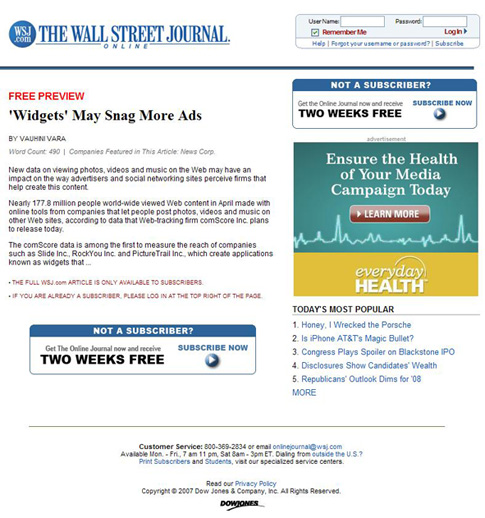A case study on aligning your email newsletter strategy with the goals of your online publishing business
There are 10 Email Design Best Practices, but, every email newsletter should have a reason for being: its business goal.
The content of the email newsletter should reflect and support this. You should be able to clearly justify and defend the business purpose behind every email you send and every item in these emails.
Does your email newsletter follow these four guidelines?
- The email newsletter has a clear, recognizable business goal.
- The email newsletter content supports this business goal 100%.
- The email newsletter includes multiple calls to action.
- The email newsletter calls to action are effective but not “pushy.”
A great example of an email newsletter with clear business goals: The Wall Street Journal
The Wall Street Journal’s business goals are very clear: to sell subscriptions.
It’s a traditional online subscription sales model. Reed Business Information used it back in 2000, and unlike many who try it, WSJ’s execution is perfect.
Is anyone else a “Top Chef” fan? If so, you’ll know what we mean when we call the WSJ Media and Marketing Edition email an “amuse bouche” – a small bite that offers a glimpse into the Chef’s personality and approach to cooking.
The WSJ email newsletter gives readers a taste of their content – and it doesn’t take long to find yourself wanting more and willing to pay for it.
[text_ad]
The issues we reviewed contained three kinds of content:
- Free articles, no strings attached
- Subscriber-only articles
- Previews, where a few paragraphs of the story (more than what appeared in the email) are available for free but the full article is for subscribers only
The email doesn’t provide any clues as to which articles are which. You only find out when you click-through to read the full story.
Types of Articles
|
Type of Article |
Average |
Range |
|
Free |
54% |
17% to 77% |
|
Subscription-only |
4% |
0% to 6% |
|
Preview |
42% |
23% to 83% |
All the email newsletter items provide you value. More than half the time (54% of article links, on average) you can click-through and read the full article without being a subscriber.
But the rest of the time (46% of article links, on average) you get some form of what we used to call a “soft door slam” (Figure 6).
It’s a soft sell, with a free two week trial, but it’s a sell. Best of all, it’s not at all pushy; it doesn’t have to be. And it happens over and over again, creating multiple calls-to-action.
Free Preview with “Soft Door Slam”

This “soft door slam” is also interesting for what it doesn’t include: an option to buy just this single article for small fee. It’s an all or nothing proposition.
The WSJ is also earning some revenue on ads. But it’s clearly a secondary model. The emails we reviewed contained the same ad in each issue, at the end just before the footer. It must bring in some revenue, but they’re clearly not looking to leverage this or make it more prominent. It’s the icing on the subscription sales cake.



Thanks Amanda. Very helpful post.
I had a hard time finding it too. You have to sign up with a free WSJ account and then select your email preferences in your “account information”.
So, the email newsletter = best practice, but the conversion to email = not so much. 🙂
This looks like a good model to follow. How do you register for the free newsletter? I don’t see anywhere to register on the site.